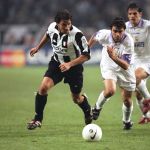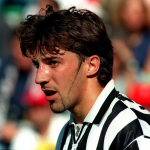
The history of Alessandro Del Piero's laces
"Del Piero goal, Del Piero style"
September 25th, 2020
On September 13th 1995, in the first Champions League match after the end of Platini’s era, Juventus is tying up 1-1 with Borussia Dortmund at Westfalen Stadion, after that Michele Padovano equalized Andreas Moller’s first goal. At 36’ Paulo Sousa’s long pass find Alessandro Del Piero that control the ball near left side of the penalty area, faced with Jurgen Kohler, another former Juventus player. Del Piero, 21 years old the next november, moves to the center entering in the penalty area and throws off Kohler with his last fake creating the space for the shot: the ball - kicked by the internal side of the right foot and the toe - climb over Stefan Klos and bags at the opposite intersection of the poles. It’s Del Piero’s first signature goal: the golden boy from Conegliano Veneto, that will score five consecutive goals in the next five Champions League games, will repeat it two weeks later against Steaua Bucarest and on October 18th against Glasgow Rangers, fuelong the narrative of the signature move that would have distinguishing him from the rest of the world in the following years.
To this iconography contribute also some aestethic details like Predator’s tongue reversed to have a better impact with the ball kicking by top of the foot and, especially, the laces using to tie the top of the socks so that they don’t fall on the shin guard. These weren’t a new: the laces. probably taken by other books, had characterized Del Piero’s rise during previous season. But Juventus #10 legitimates his the next big thing dimension on that european stage.
While charming all european fields, Del Piero can’t imagine that his expedient - originally designed to better comfort on the pitch - became the new canon of elegance on the pitch, inspiring a generation of kids, stunned by hypnotic swing of that appendices that move to the rhythm of Pinturicchio’s run and dribbling. So Del Piero decides to patent all, playing with the colorways: the laces are black with blue or white socks and white on black socks. The laces became a trademarks almost like Del Piero’s curve shot, enough to represent a specific part of his career: after winning a lot of trophies, the laces disappear during the difficult seasons before the terrible injury in november 1998. As if the levity and the juvenile sensation of invincibility was replaced by something new, something different: the awareness that also a great champion have to fight to return to himself, without concentrating on unnecessary details.
Also aesthetically. Del Piero with laces was a star that dared to in and off the pitch - sometimes going too far, like here - with his distinctive pointed sideburns and shaped goatee accompanying his haircut short before then longer and longer. In 1997/1998 season, his best season ever, Del Piero is the first italian pop icon thanks his long and grasy hair, becoming one of the most famous Luxottica’s face. The injury takes away his juvenile vibrancy also from this point of view: in the following years goatee disappear, sideburns become more regular, haircut more squared, with few exeprimentations, like “mongol” mustaches at 2002 World Cup or the total shaving four years later in Germany. Del Piero becomes, aesthetically speaking, more reliable, almost ordinary, in opposition to his timeless footballing world class.
But Del Piero’s aesthetic sense don’t disappear. As a american sports great fan, Juventus legend introduces into italian culture two more cult accesorizes: during 2003/2004 season becomes the first footballer with a “finger save” like NBA players, with the colorways associated to the jersey (black with yellow stilized number on Juventus black and withe jersey, blue with white number on Italy’s National Team total blue jersey); during 2006/2007, while is leading Juventus in Serie B championship, continues the tradition of the wristband on lower arm look like Michal Jordan - or Thierry Henry and Nicolas Anelka in the early 2000’s. Del Piero would bring wristbands also during his experience in Australia and India, associating them with the colorful jerseys of Sydney FC and Delhi Dynamos.
But nothing would have been like that laces, a distinguishing mark like his signature move: the “Del Piero gol” with “Del Piero’s laces”.








































.png)


.jpg)





















































































